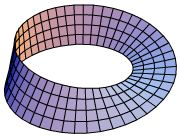Configuration space
In classical mechanics, the parameters that define the configuration of a system are called generalized coordinates, and the vector space defined by these coordinates is called the configuration space of the physical system. It is often the case that these parameters satisfy mathematical constraints, such that the set of actual configurations of the system is a manifold in the space of generalized coordinates. This manifold is called the configuration manifold of the system.
Configuration spaces in physics
Particle
The position of a single particle moving in ordinary Euclidean 3-space is defined by the vector r=(x, y, z), and therefore its configuration space is R3. If the particle is constrained to lie on a sphere, then its configuration space is the subset of coordinates in R3 that define points on the sphere S2.
For n particles the configuration space is R3n, or possibly the subspace where no two positions are equal.
An important problem in physics considers the set of all trajectories of a particle between two points, which is a configuration space that is also known as a function space M. In quantum mechanics one formulation uses histories, or trajectories, as configurations.
Rigid body
The set of coordinates that define the position of a reference point and the orientation of a coordinate frame attached to a rigid body in three-dimensional space form its configuration space, often denoted where represents the coordinates of the origin of the frame attached to the body, and represents the rotation matrices that define the orientation of this frame relative to a ground frame. A configuration of the rigid body is defined by six parameters, three from and three from , and is said to have six degrees of freedom.
In Robotics, configuration space refers to the set of reachable positions by a robot's end-effector, considered as a rigid body in three-dimensional space.[1] Thus positions of the end-effector of a robot can be identified with the group of spatial rigid transformations, often denoted SE(3).
The joint parameters of the robot are used as generalized coordinates to define configurations. The set of joint parameter values is called the joint space. A robot's forward and inverse kinematics equations define maps between configurations and end-effector positions, or between joint space and configuration space. Robot motion planning uses this mapping to find a path in joint space that provides an achievable route in the configuration space of the end-effector.
Phase space
In Mechanics, the configuration of a system consists of the positions had by all components subject to kinematical constraints.[2] The set of velocities available to a system defines a plane tangent to the configuration manifold of the system. Momentum vectors are linear functionals of the tangent plane, known as cotangent vectors. Thus, the set of positions and momenta of a mechanical system forms the cotangent bundle of the configuration manifold.
This larger manifold is called the phase space of the system. The joint space and configuration space can be viewed as a bijection on the phase space of a mechanical system.
Configuration spaces in mathematics

In mathematics a configuration space refers to a broad family of constructions closely related to the state space notion in physics. The most common notion of configuration space in mathematics is the set of n-element subsets of a topological space . This set is given a topology by considering it as the quotient where and is the symmetric group acting by permuting the coordinates of . Typically, is called the configuration space of n unordered points in and is called the configuration space of n ordered or colored points in ; the space of n ordered not necessarily distinct points is simply
If the original space is a manifold, the configuration space of distinct, unordered points is also a manifold, while the configuration space of not necessarily distinct unordered points is instead an orbifold.
Configuration spaces are related to braid theory, where the braid group is considered as the fundamental group of the space .
A configuration space is a type of classifying space or (fine) moduli space. In particular, there is a universal bundle which is a sub-bundle of the trivial bundle , and which has the property that the fiber over each point is the n element subset of classified by p.
The homotopy type of configuration spaces is not homotopy invariant – for example, the spaces are not homotopy equivalent for any two distinct values of . For instance, is not connected, is a , and is simply connected for .
It used to be an open question whether there were examples of compact manifolds which were homotopy equivalent but had non-homotopy equivalent configuration spaces: such an example was found only in 2005 by Longoni and Salvatore. Their example are two three-dimensional lens spaces, and the configuration spaces of at least two points in them. That these configuration spaces are not homotopy equivalent was detected by Massey products in their respective universal covers.[3]
See also
- Feature space (topic in pattern recognition)
- Parameter space
- Phase space
- State space (physics)
References
- ↑ John J. Craig, Introduction to Robotics: Mechanics and Control, 3rd Ed. Prentice-Hall, 2004
- ↑ Sussman, Gerald (2001). Structure and interpretation of classical mechanics. Cambridge, Mass: MIT Press. ISBN 0262194554.
- ↑ Salvatore, Paolo; Longoni, Riccardo (2005), "Configuration spaces are not homotopy invariant", Topology, 44 (2): 375–380, doi:10.1016/j.top.2004.11.002
External links
- Intuitive Explanation of Classical Configuration Spaces.
- Interactive Visualization of the C-space for a Robot Arm with Two Rotational Links from UC Berkeley.
- Configuration Space Visualization from Free University of Berlin